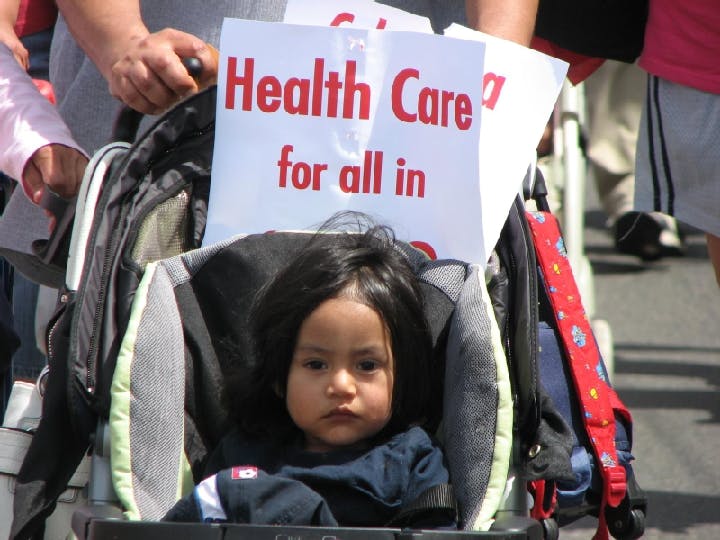How inequality and demographics could shorten American life expectancy
– Elizabeth Peet
Without reforming education, employment, and immigration policy, America may soon see a drop in average life expectancy.
Life expectancy has long been a useful measure of progress and development, a sort of numerical yardstick testing a society’s fundamental duty to care for its citizens at every stage of life. Over the course of generations, massive improvements in public health and advances in medicine and technology have primed advanced societies to steady increases in life expectancy and standards of living.
Those assumptions, cautions S. Jay Olshansky, are increasingly tenuous, with demographic trends suggesting worrying patterns for the future. In Daedalus, Olshansky, a professor of epidemiology at the University of Illinois, limns out these troubling demographic trends and reaches some startling conclusions.
As with most Western nations, the U.S. population is rapidly aging. In 1900, just over one in twenty-five Americans were aged sixty-five or older. Today, that prevalence has more than tripled: one in seven Americans is over age sixty-five; by 2050, it will likely by one in five. But while the average health status of older Americans has improved over the last half century, Olshansky writes that closer examination shows “population subgroups within the United States are simultaneously moving in opposite directions with regard to future longevity.”
For instance, America’s Latino population makes up seventeen percent of the total U.S. population, and is projected to rise to roughly twenty-eight percent by 2060. Latino immigrants over age sixty-five are, on average, healthier than any other ethnicity at that age, despite socioeconomic disadvantages. This, says Olshansky, is largely due to low levels of cigarette smoking and ‘positive health selection’ at the time of immigration — referring to the reality that only the healthiest are able to migrate to the U.S. in the first place.
For younger Hispanics, the future is less rosy. Evidence shows that second- and third-generation Latino immigrants are adopting increasingly harmful health and behavioral patterns, resulting in high levels of obesity and diabetes, and eroding the high standards of health in America’s Latino population. Ongoing socioeconomic inequalities, diminished levels of health, and increased rates of obesity and diabetes entrench troubling patterns as far as health and lifespan are concerned. Among Hispanics, writes Olshansky, longevity is “spiraling downward,” and in the coming years will have a “notable negative impact” on national life expectancy and health statistics.
Robert Hummer and Mark Hayward, two professors from University of Texas, explore this dynamic further. Also writing in Daedalus, they point to the fact that compared to America’s non-Hispanic white population, Latinos are more likely to work in physically taxing jobs, causing more ‘wear and tear’ on the body and an increasing the likelihood of physical disability in old age. Moreover, middle-aged and older Latino immigrants typically face limited access to health insurance. According to a 2014 Gallup poll, less than eleven percent of uninsured Hispanics obtained health coverage during open enrollment periods, compared with increases of sixteen percent among black Americans and fourteen percent among whites. Hummer and Hayward claim that this is due to restrictions imposed by several large states (e.g. Texas and Florida) on the availability of Medicaid to low income families under the Affordable Care Act. Such health disparities seem likely to persist, synchronic with yawning gaps in economic well-being. On average, the total wealth of the average Latino household in the U.S. is equivalent to roughly one-sixteenth that of the average white household — a gap which is widening. Educational attainment rates are similarly troubling: the Pew Research Center found that Hispanics are less likely than any other American ethnic group to graduate from college or high school.
For millions of undocumented Latino immigrants living in America, challenges are even more substantial and pervasive: pitiful wages and working conditions, a lack of access to public healthcare or social services, and constant stress, worry, and insecurity — all of which have profoundly negative consequences on health and life expectancy. With seventy-three percent of the children of undocumented immigrants being natural-born U.S. citizens, these poor health standards will have a significant impact on America’s overall wellbeing and health statistics in the years and decades to come.
Wisconsin-based journalist Doug Larson once quipped that “life expectancy would grow in leaps and bounds if green vegetables smelled as good as bacon.” He undoubtedly had a point, but it is clear that poor health and low life expectancy are not only caused by behavioral patterns, but by structural societal flaws, which can be rectified (or at least ameliorated) by the state through policy reforms. Hummer and Hayward suggest several meaningful changes: better integration of Latino and immigrant populations into state-run healthcare options; increasing access to higher education; fighting the rise of obesity in young people; and helping immigrant workers and the working poor by enforcing the minimum wage, subsidizing housing, and providing affordable childcare options.
As the Latino population’s prominence in American life rises, their health outcomes and socioeconomic opportunities will be increasingly relevant to both national statistics and America’s standard of living. Without serious reforms in immigration, healthcare, education, and employment, ongoing disparities may shorten the lifespan of what we think of as the American way of life.
* * *
The Sources:
S. Jay Olshansky, “The Demographic Transformation of America,” Daedalus, Vol.144 No.2 (Spring 2015)
Robert A. Hummer and Mark D. Hayward, “Hispanic Older Adult Health and Longevity in the United States: Current Patterns and Concerns for the future,” Daedalus, Vol.144 No.2 (Spring 2015)
Cover image courtesy of Flickr/NeilParekh
